Optimization of Wire Arc Additive Manufacturing (WAAM) Process for the Production of Mechanical Components Using a CNC Machine
Abstract
1. Introduction
2. Materials and Methods
- -
- Yield strength of 380 N/mm2 (depending on shielding gas);
- -
- Tensile strength of 490 N/mm2 (depending on shielding gas).
- -
- The final part was produced with 2 passes/layer with a gap between layers of 4 mm;
- -
- Amperage of 130 A;
- -
- 15 L/min gas flow.
- Welding source: Sincosald Nova Plus 500 e inverter with Feeder 4R NSP wire feeder.
- Shielding gas used: Argon 85% + CO2 15% mixture (Corgon 18-Linde).
- Yaskawa robot model MH 24—for welding gun operation.
- Yaskawa positioning device model DK 250—capacity of 2500 kg used to fix and rotate the substrate material.
- Protection, control, and robot control panel and positioning device.
2.1. Residual Stresses and Strains
- -
- The efficiency of the process for a single piece was only 45%. From a productive point of view, there were apparently massive losses. Nonetheless, the inefficiency of the process can be significantly diminished if two components were produced in parallel or by implementing an efficient cooling system.
- -
- Deposition rate: it was necessary to perform 4 seams/layer instead of 2. If two parts had been produced in parallel, the amperage (Is) could have been higher because there would have been enough cooling time between the deposits.
- -
- The maximum temperature of the deposited layer, i.e., 300 °C, before the start of the welding/deposition of the consecutive layer proved to be correct because, following the controls carried out, the deformation of the substrate material was less than 0.5 mm—measured at the inner diameter of the tubular substrate blank [25].
2.2. Preparation of the Piece for Turning
2.2.1. Cutting
2.2.2. Turning
2.2.3. Blasting and Preparing the Part for 3D Scanning
2.2.4. Shaping the Piece
2.2.5. Correction of the Part
3. Results and Examination
3.1. Visual Control
3.2. Dimensional Checks
3.3. Hardness Control
3.4. Metallographic Attack
3.5. Microscopic Examination—Interpretation
3.6. Substrate/Basic Material Area 1
3.7. Economic Calculation
4. Manufacturing Costs Using WAAM Materials
4.1. Raw Material Costs Using the Classic CNC Cutting Process
4.2. WAAM Total Cost Comparison—CNC Cutting
5. Conclusions
- -
- Regarding the economic aspect—the WAAM process is not recommended for the construction of parts with a simple geometry, because the classical manufacturing processes are much better optimized and adapted in this respect.
- -
- Regarding the efficiency of the WAAM process in the case of the product presented in this paper, for a single workpiece, it was only 45%, and from a production point of view, the difference was represented as losses. The inefficiency of the process can be significantly diminished if two parts were produced in parallel or by implementing an efficient cooling system.
- -
- In the case of deposition rate for the product developed in this study case: it was necessary to perform four layers instead of two. If two parts had been produced in parallel, the welding current could have been higher because there would have been enough cooling time between the deposits
- -
- In terms of stresses and deformations, the situation resulted from parameters, and the maximum underpass temperature of the deposited layer, i.e., 300 °C, proved to be correct because following the controls carried out, the deformation of the substrate material was less than 0.5 mm—measured at the inner diameter of the tubular substrate blank.
- -
- Regarding the resolution for the product developed in this study case, the quality of the surfaces of the parts obtained by WAAM was not very high, as further processing was required, but the quantity of material deposited in excess was good compared to the other advantages that this process brings.
- -
- In terms of slicing, there are several pieces of software on the market that provides the interface between the CAD model and the robot’s operating program, but due to the geometric complexity of the parts, the diversity of materials, and the numerous final uses of the finished products, there are real difficulties in correctly programming welding cycles that may differ from layer to layer within the same part.
- -
- Studying the possibility of producing the flange by executing only two weld seams per layer instead of the four current seams as well.
- -
- Studying the impact on the mechanical properties of the part.
- -
- Using a forced cooling system with cooled air at low temperatures (−20 °C, −30 °C) and studying the effects of forced cooling on the mechanical properties of the part.
Author Contributions
Funding
Institutional Review Board Statement
Informed Consent Statement
Data Availability Statement
Acknowledgments
Conflicts of Interest
References
- Gibson, I.; Rosen, D.; Stucker, B. Additive Manufacturing Technologies. 3D Printing, Rapid Prototyping, and Direct Digital Manufacturing, 2nd ed.; Springer: Berlin/Heidelberg, Germany, 2015; ISBN 978-1-4939-2113-3. [Google Scholar]
- ISO/ASTM 52900; Standard Terminology for Additive Manufacturing–General Principles–Terminology. International Organization for Standardization (ISO): Geneva, Switzerland, 2015.
- Spalek, N.; Brunow, J.; Braun, M.; Rutner, M. WAAM-Fabricated Laminated Metal Composites. Metals 2021, 11, 1948. [Google Scholar] [CrossRef]
- Available online: https://ultimaker.com/learn/how-to-design-for-fff-3d-printing (accessed on 5 September 2022).
- Gafe, C.A.; Gangula, B.; Illinda, P. A Deloitte Series on Additive Manufacturing. 2014. Available online: https://www2.deloitte.com/xe/en/insights/focus/3d-opportunity/additive-manufacturing-3d-opportunity-in-automotive.html (accessed on 5 September 2022).
- Vafadar, A.; Guzzomi, F.; Rassau, A.; Hayward, K. Advances in Metal Additive Manufacturing: A Review of Common Processes, Industrial Applications, and Current Challenges. Appl. Sci. 2021, 11, 1213. [Google Scholar] [CrossRef]
- Safia, A.; Rima, D.; Nouredine, F. Effect of the Laser Scan Rate on the Microstructure, Magnetic Properties, and Microhardness of Selective Laser-Melted FeSiB. J. Supercond. Nov. Magn. 2018, 31, 3565–3567. [Google Scholar]
- Available online: https://mx3d.com/ (accessed on 7 September 2022).
- BASF. Ultrafuse 316L: User Guidelines for 3D Printing Metal Parts; BASF: Limburgerhof, Germany, 2021. [Google Scholar]
- Available online: https://ro.disoncasting.com/precision-investment-casting/auto-part-casting/auto-flange.html (accessed on 5 September 2022).
- Shen, Y.; Li, Y.; Chen, C.; Tsai, H.L. 3D printing of large, complex metallic glass structures. Mater. Des. 2017, 117, 213–222. [Google Scholar] [CrossRef]
- Available online: https://www.dezeen.com/2021/07/19/mx3d-3d-printed-bridge-stainless-steel-amsterdam/ (accessed on 5 September 2022).
- Suzuki, K.; Hujimori, H.; Hashimoto, K. Amorphous Metals; Masumoto, T., Ed.; Metallurgy: Moscow, Russia, 1987; p. 328. (In Japanese) [Google Scholar]
- Liang, S.; Wang, X.; Zhang, W.; Liu, Y.; Wang, W.; Zhang, L. Selective laser melting manufactured porous Fe-based metallic glass matrix composite with remarkable catalytic activity and reusability. Appl. Mater. Today 2020, 19, 100543. [Google Scholar] [CrossRef]
- Available online: https://www.twi-global.com/technical-knowledge/job-knowledge/arc-based-additive-manufacturing-137 (accessed on 15 September 2022).
- Polley, C.; Distler, T.; Detsch, R.; Lund, H.; Springer, A.; Boccaccini, A.R.; Seitz, H. 3D Printing of Piezoelectric Barium Titanate-Hydroxyapatite Scaffolds with Interconnected Porosity for Bone Tissue Engineering. Materials 2020, 13, 1773. [Google Scholar] [CrossRef]
- Jafari, D.; Vaneker, T.H.J.; Gibson, I. Wire and arc additive manufacturing: Opportunities and challenges to control the quality and accuracy of manufactured parts. Mater. Des. 2021, 202, 109471. [Google Scholar] [CrossRef]
- Nam, Y.G.; Koo, B.; Chang, M.S.; Yan, S.; Yu, J.; Park, Y.H.; Jeong, J.W. Selective laser melting vitrification of amorphous soft magnetic alloys with help of double-scanning-induced compositional homogeneity. Mater. Lett. 2020, 261, 127068. [Google Scholar] [CrossRef]
- Treutler, K.; Wesling, V. The Current State of Research of Wire Arc Additive Manufacturing (WAAM): A Review. Appl. Sci. 2021, 11, 8619. [Google Scholar] [CrossRef]
- Lindroos, T.; Riipinen, T.; Metsä-Kortelainen, S.; Pippuri-Mäkeläinen, J.; Lagerbom, J.; Revuelta, A.; Metsäjoki, J. Soft magnetic alloys for selective laser melting. In Proceedings of the EuroPM 2017 Congress and Exhibition, Milan, Italy, 1–5 October 2017. [Google Scholar]
- Ouyang, D.; Zhang, P.; Zhang, C.; Liu, L. Understanding of crystallization behaviors in laser 3D printing of bulk metallic glasses. Appl. Mater. Today 2021, 23, 100988. [Google Scholar] [CrossRef]
- Zrodowski, Ł.; Wysocki, B.; Wróblewski, R.; Kurzydłowski, K.J.; Świeszkowski, W. The novel scanning strategy for fabrication metallic glasses by selective laser melting. In Proceedings of the Fraunhofer Direct Digital Manufacturing Conference 2016, Berlin, Germany, 16–17 March 2016. [Google Scholar]
- Zou, Y.; Wu, Y.; Li, K.; Tan, C.; Qiu, Z.; Zeng, D. Selective laser melting of crack-free Fe-based bulk metallic glass via chessboard scanning strategy. Mater. Lett. 2020, 272, 127824. [Google Scholar] [CrossRef]
- Available online: https://thermalprocessing.com/advantages-of-wire-arc-additive-manufacturing/ (accessed on 5 September 2022).
- Kabir, S.F.; Mathur, K.; Seyam, A.F.M. Seyam: A Critical Review on 3D Printed Continuous Fiber-Reinforced Composites: History, Mechanism, Materials, and Properties, Composite Structures; Elsevier: Amsterdam, The Netherlands, 2019. [Google Scholar]
- Ouyang, D.; Wei, X.; Li, N.; Li, Y.; Liu, L. Structural evolutions in 3D-printed Fe-based metallic glass fabricated by selective laser melting. Addit. Manuf. 2018, 23, 246–252. [Google Scholar] [CrossRef]
- Ozden, M.; Morley, N. Laser Additive Manufacturing of Fe-Based Magnetic Amorphous Alloys. Magnetochemistry 2021, 7, 20. [Google Scholar] [CrossRef]
- Maciąg, F.; Moskalewicz, T.; Kowalski, K.; Łukaszczyk, A.; Hadzhieva, Z.; Boccaccini, A.R. The Effect of Electrophoretic Deposition Parameters on the Microstructure and Adhesion of Zein Coatings to Titanium Substrates. Materials 2021, 14, 312. [Google Scholar] [CrossRef]
- Jiang, Q.; Zhang, P.; Tan, J.; Yu, Z.; Tian, Y.; Ma, S.; Wu, D. Influence of the microstructure on mechanical properties of SLM additive manufacturing Fe-based bulk metallic glasses. J. Alloys Compd. 2021, 894, 162525. [Google Scholar] [CrossRef]
- Bordeenithikasem, P.; Hofmann, D.; Firdosy, S.; Ury, N.; Vogli, E.; East, D. Controlling microstructure of FeCrMoBC amorphous metal matrix composites via laser directed energy deposition. J. Alloys Compd. 2020, 857, 157537. [Google Scholar] [CrossRef]
- TS 14-123-149-2009; Rapidly Hardened Tape of Soft–Magnetic Amorphous Alloys and Soft–Magnetic Composite Material (Nanocrystalline Alloy). Asha, Russia. 2011.
- Li, Y.; Su, C.; Zhu, J. Comprehensive review of wire arc additive manufacturing: Hardware system, physical process, monitoring, property characterization, applicationd and future prospects. Results Eng. 2022, 13, 100330. [Google Scholar] [CrossRef]
- Jung, H.Y.; Choi, S.J.; Konda, G.P.; Mihai, S.; Sergio, S.; Seonghoon, Y.; Uta, K.; Kim, D.H.; Kim, K.B.; Eckertaf, J. Fabrication of Fe-based bulk metallic glass by selective laser melting: A parameter study. Mater. Des. 2015, 86, 703–708. [Google Scholar] [CrossRef]
- Zrodowski, Ł.; Wysocki, B.; Wróblewski, R.; Krawczynska, A.; Adamczyk-Cieslak, B.; Zdunek, J.; Błyskun, P.; Ferenc, J.; Leonowicz, M.; Świeszkowski, W. New approach to amorphization of alloys with low glass forming ability via selective laser melting. J. Alloys Compd. 2019, 771, 769–776. [Google Scholar] [CrossRef]
- Golod, V.M.; Sufiiarov, V.S. The evolution of structural and chemical heterogeneity during rapid solidification at gas atomization. IOP Conf. Ser. Mater. Sci. Eng. 2017, 192, 012009. [Google Scholar] [CrossRef]
- Gao, S.; Yan, X.; Chang, C.; Aubry, E.; He, P.; Liu, M.; Liao, H.; Fenineche, N. Microstructure and magnetic properties of FeSiBCrC soft magnetic alloy manufactured by selective laser melting. Mater. Lett. 2021, 290, 129469. [Google Scholar] [CrossRef]
- Salunkhe, S.; Amancio-Filho, S.T.; Davim, J.P.J. Advances in Metal Additive Manufacturing; Elsevier: Amsterdam, The Netherlands, 2022. [Google Scholar]
- Available online: https://www.esab.co.uk/gb/en/products/filler-metals/mig-mag-wires-gmaw/mild-steel-wires/weld-g3si1.cfm (accessed on 12 September 2022).
- Chandrasekaran, S.; Hari, S.; Amirthalingam, M. Wire arc additive manufacturing of functionally graded material for marinerisers. Mater. Sci. Eng. A 2020, 792, 139530. [Google Scholar] [CrossRef]
- Załuska, A.; Matyja, H. Crystallization characteristics of amorphous Fe-Si-B alloys. J. Mater. Sci. 1983, 18, 2163–2172. [Google Scholar] [CrossRef]
- Li, Y.; Shen, Y.; Chen, C.; Leu, M.; Tsai, H.L. Building metallic glass structures on crystalline metal substrates by laser-foil-printing additive manufacturing. J. Mater. Process. Technol. 2017, 248, 249–261. [Google Scholar] [CrossRef]
- Von Mises, L. Human Action; Ludwig von Mises Institute: Auburn, AL, USA, 2010; pp. 200–230. [Google Scholar]
- Buta, I.; Pavăl, C. Realizarea unei Flanșe de Legătură între un Universal de Strung și o Masă Rotativă Folosind Procedeul WAAM (Wire Arc Aditive Manufacturing). Master’s Thesis, Department of Materials and Manufacturing Engineering, Mechanical Faculty, Polytechnic University Timisoara, Timișoara, Romania, 2022. [Google Scholar]



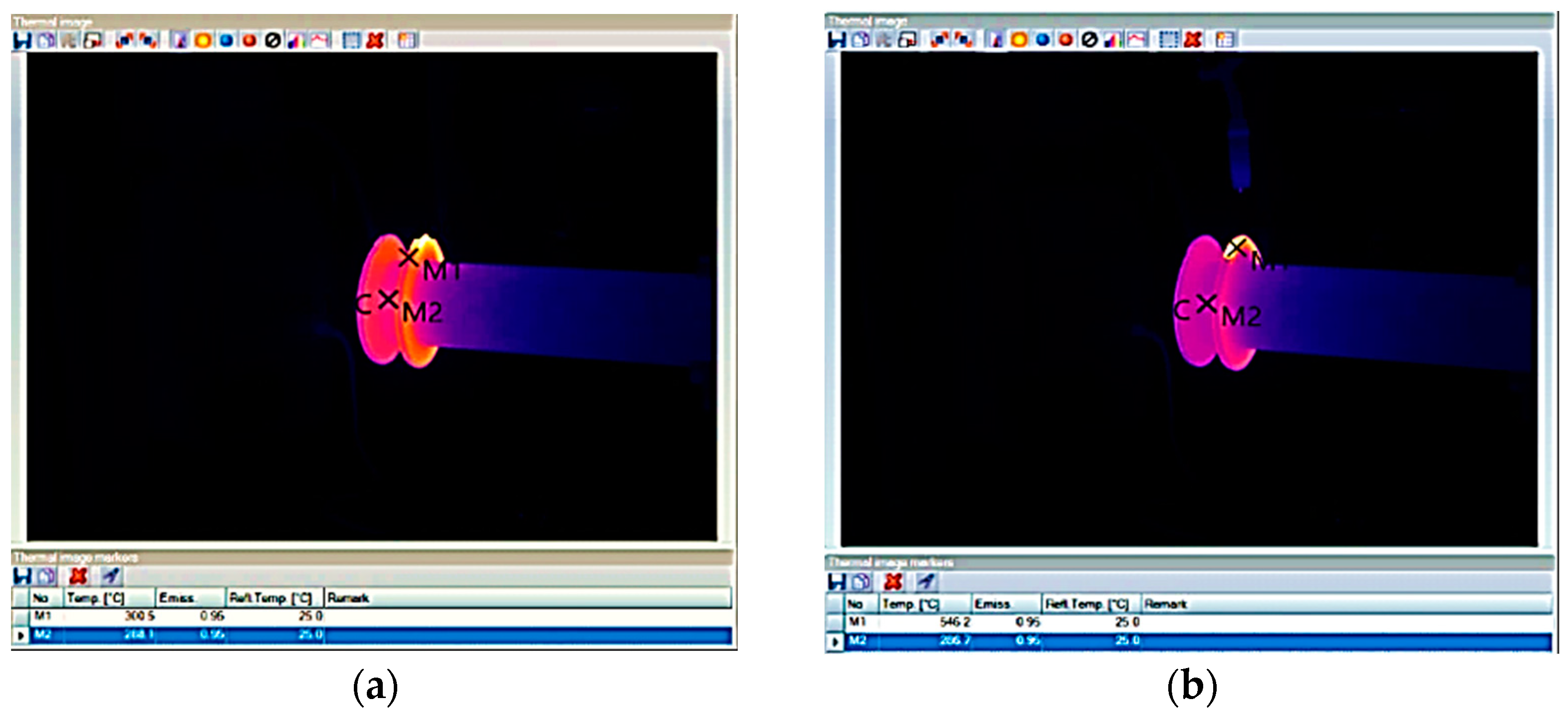
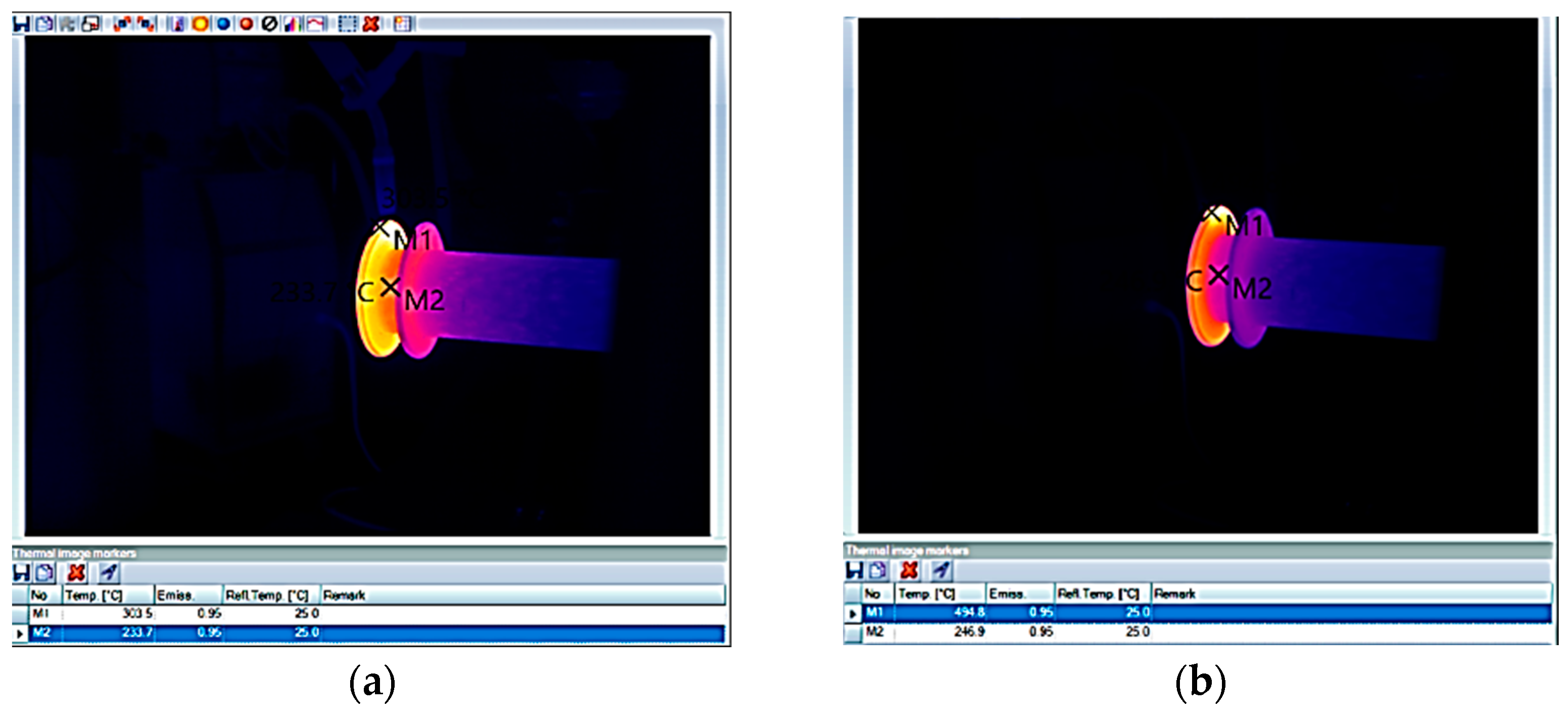
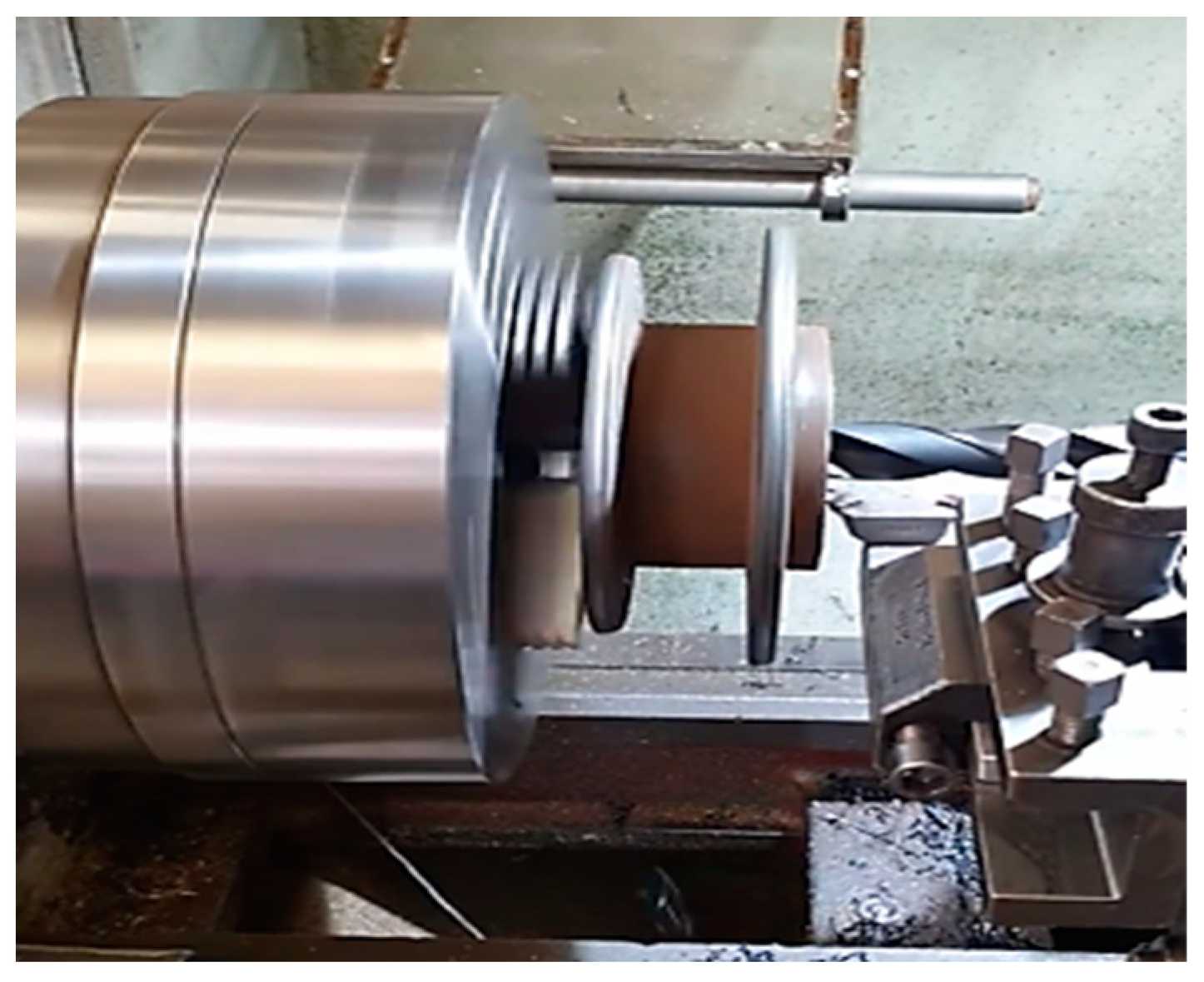



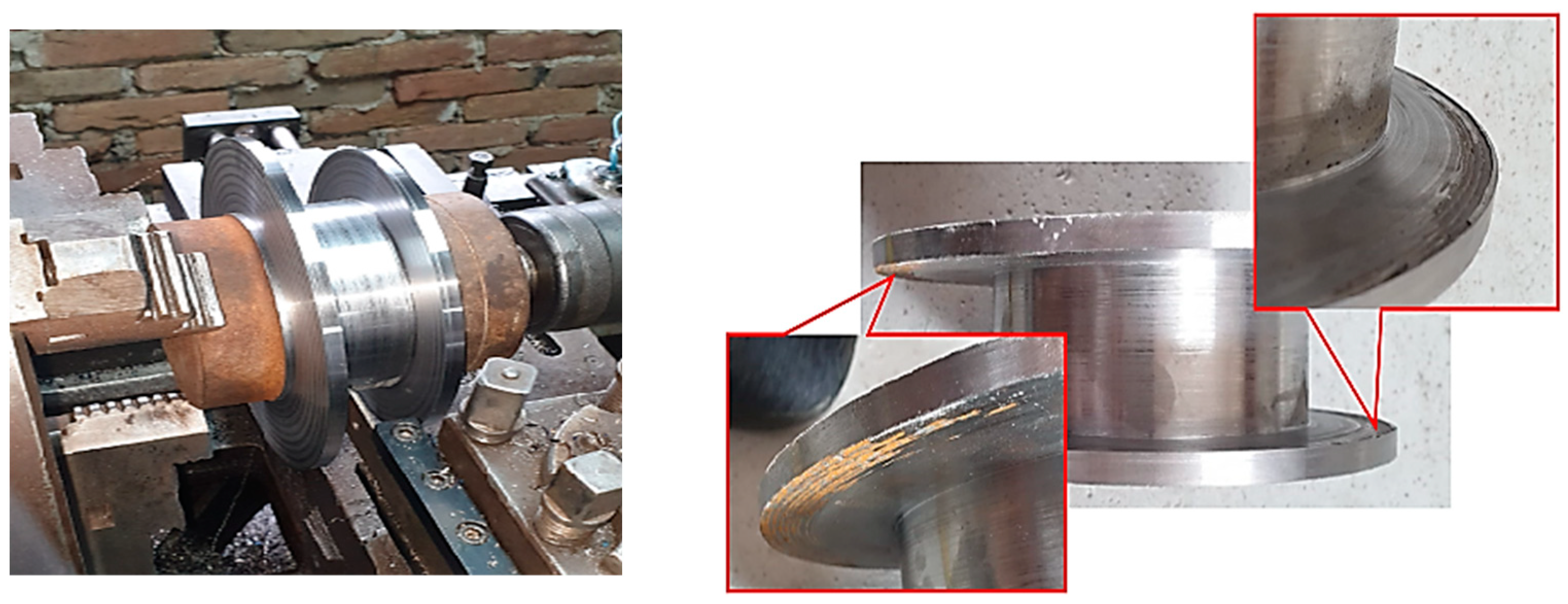
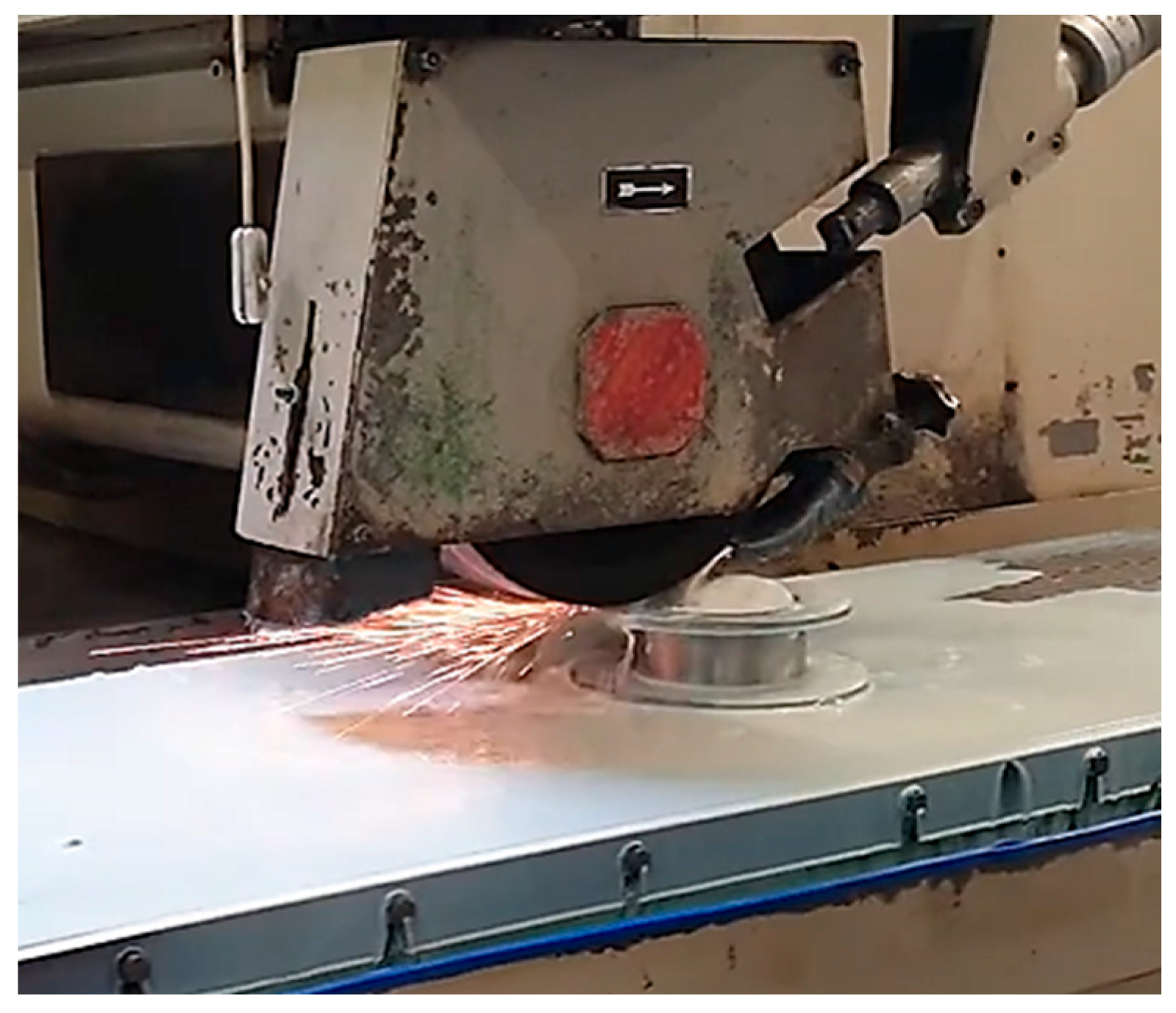
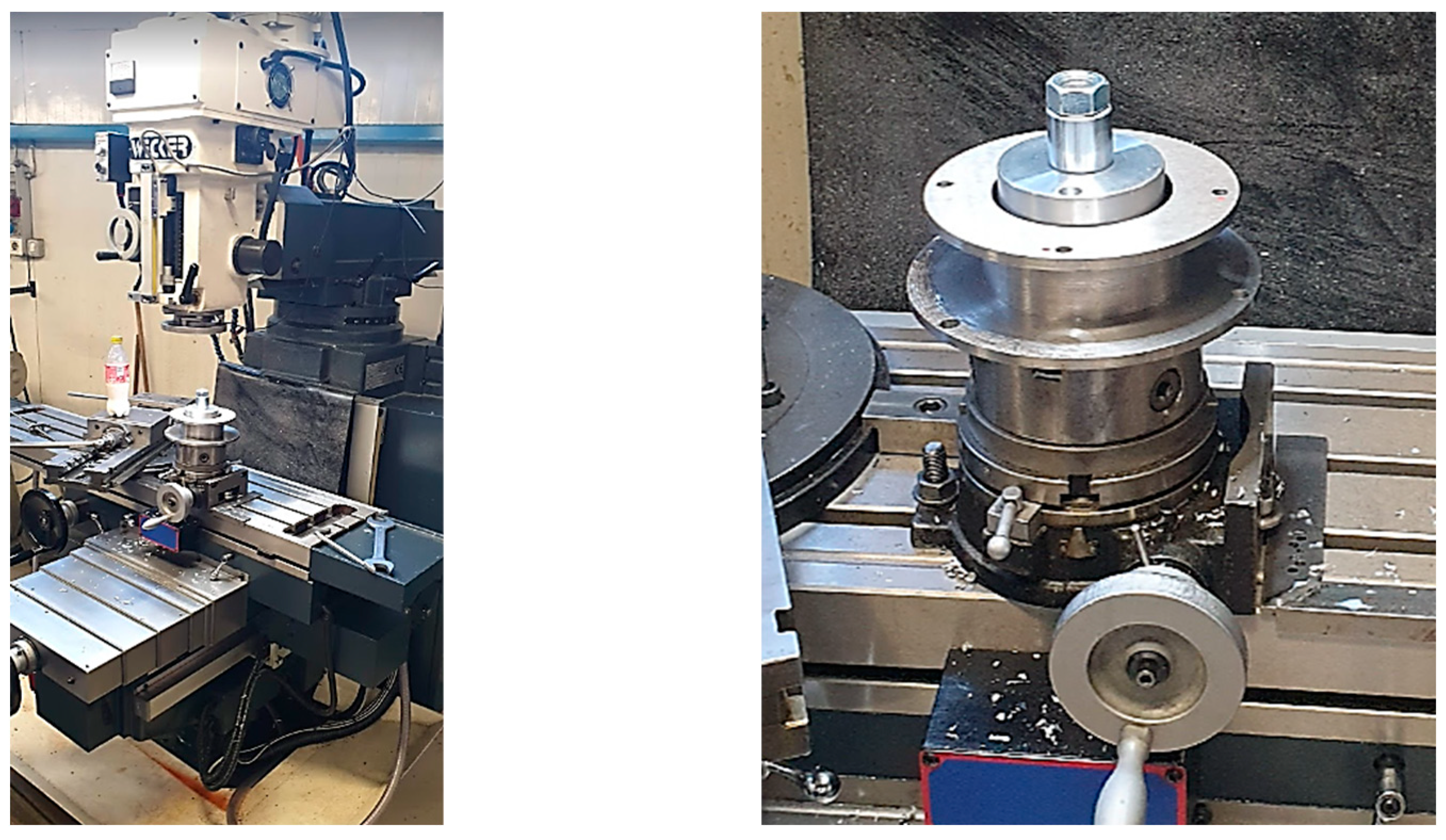
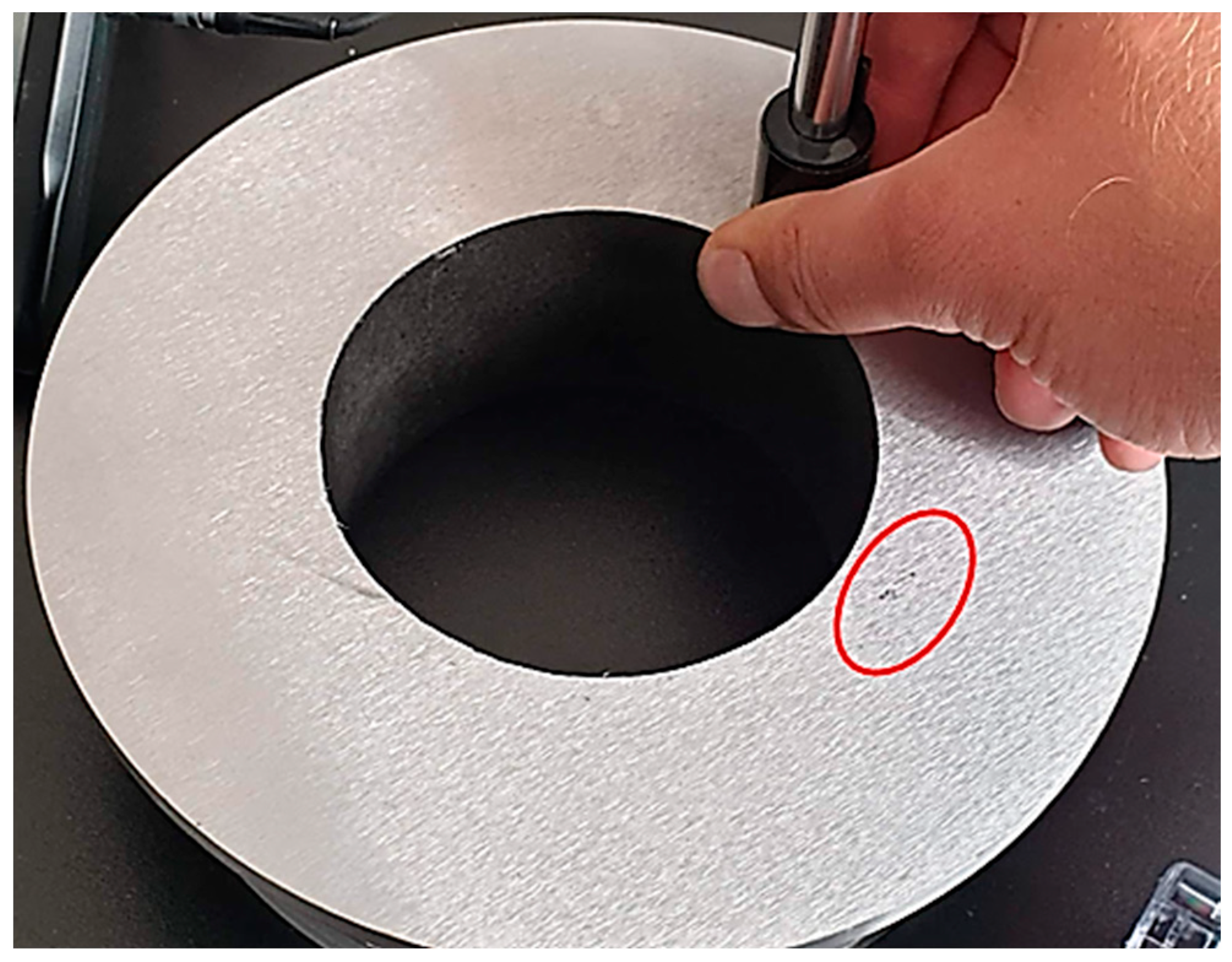
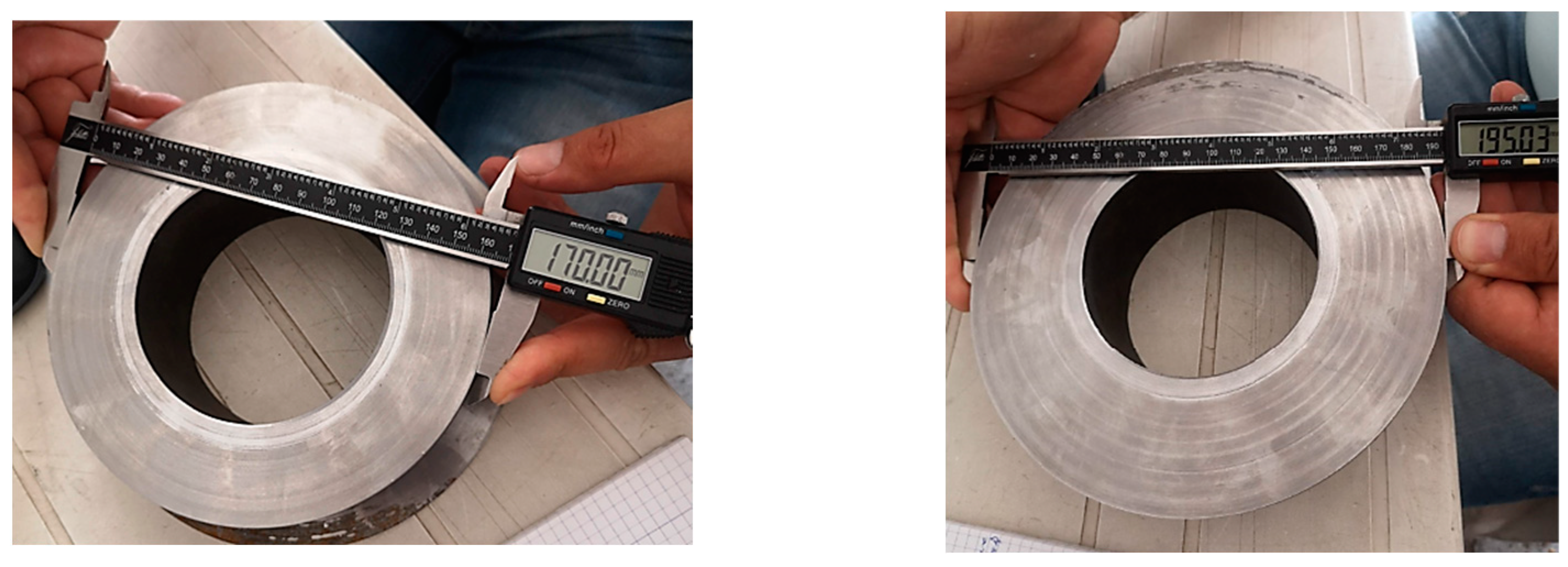
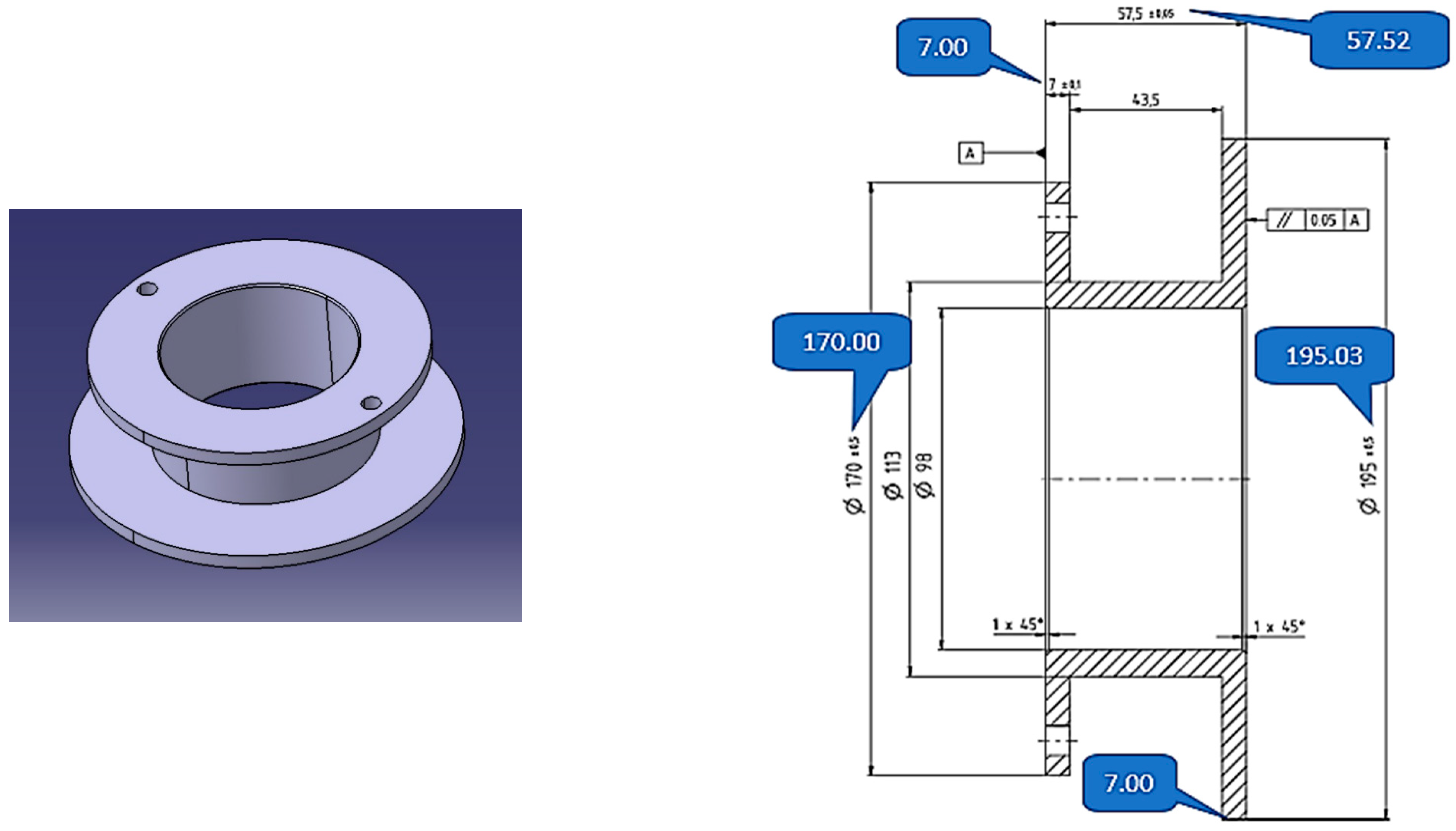
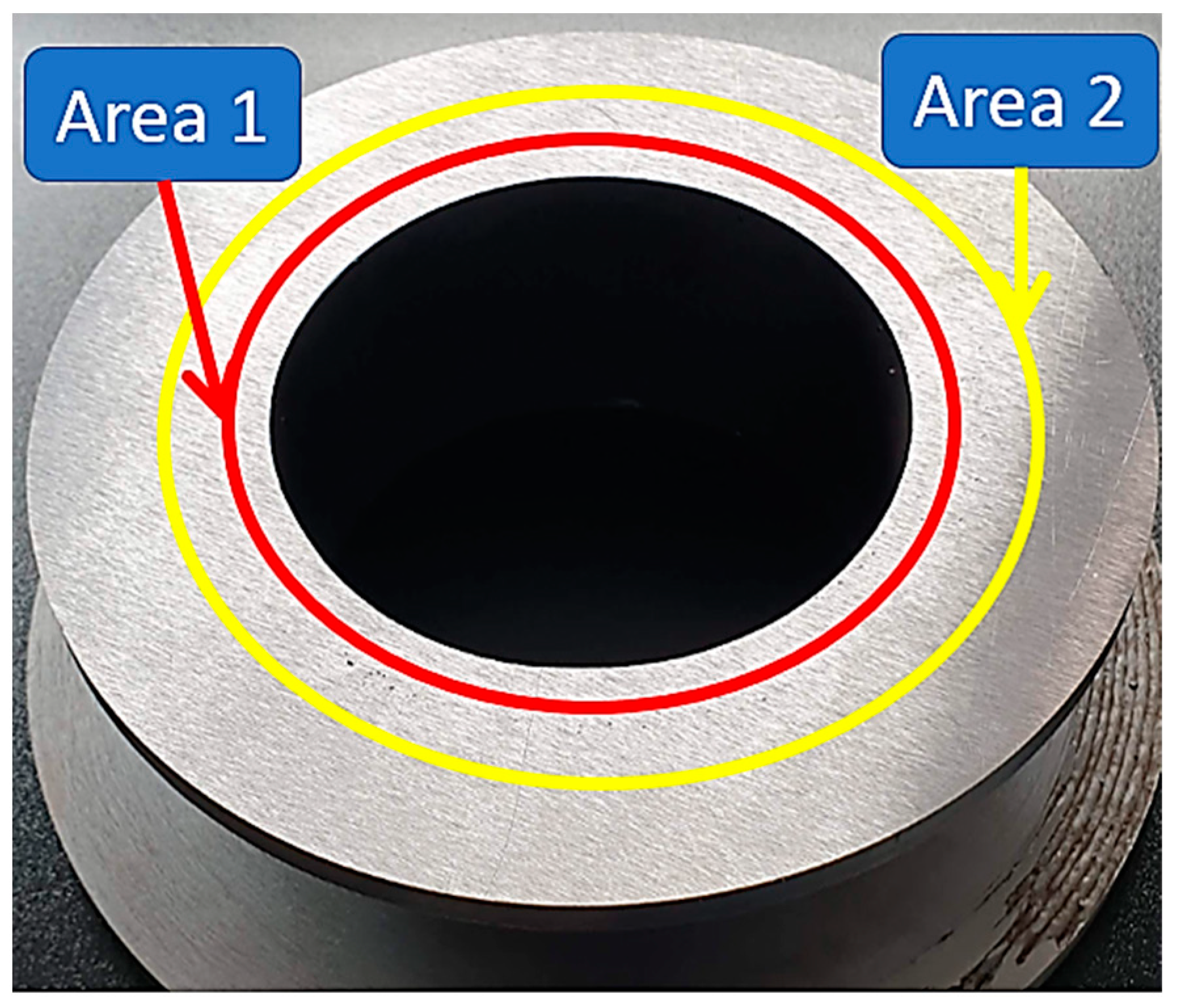

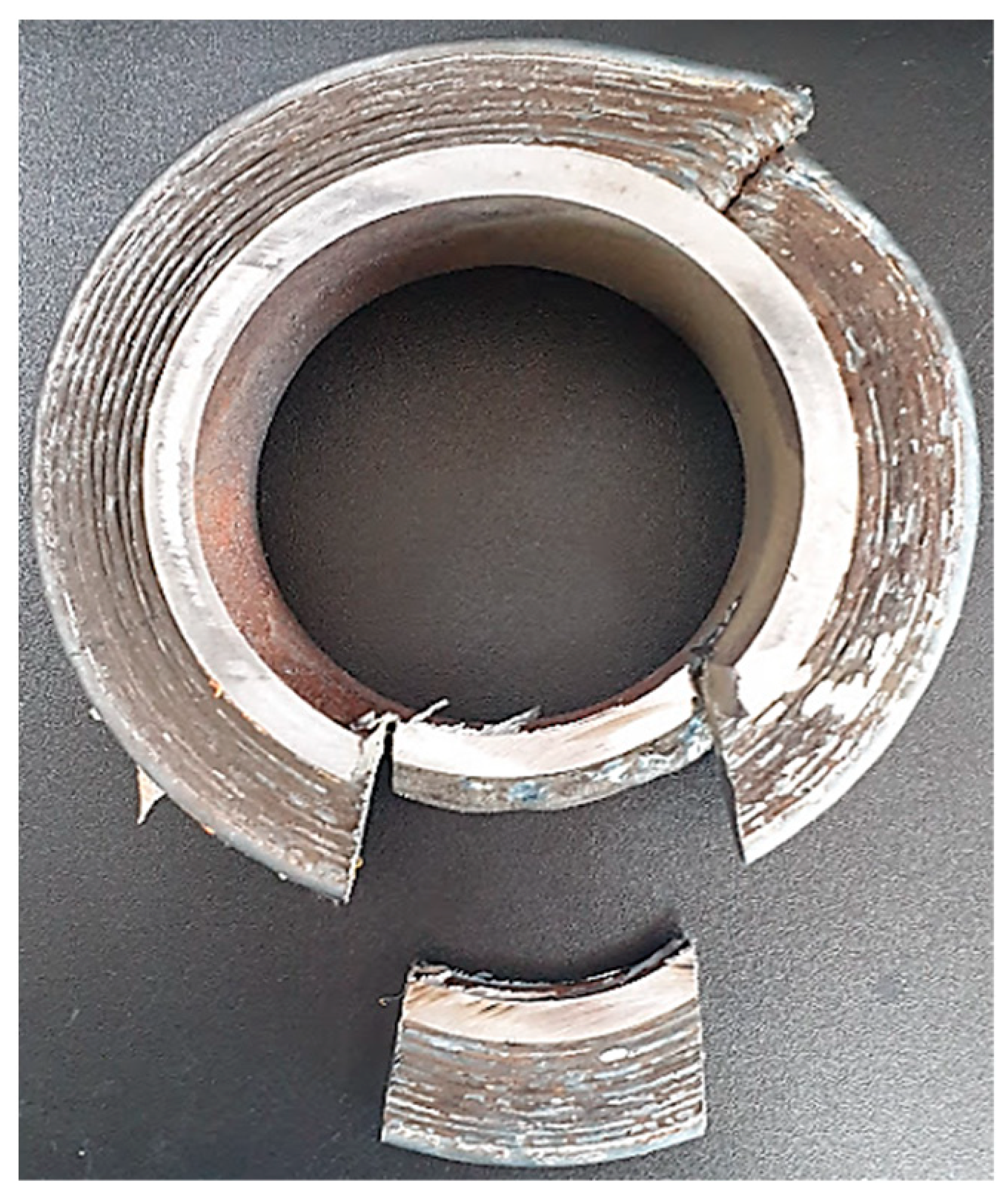
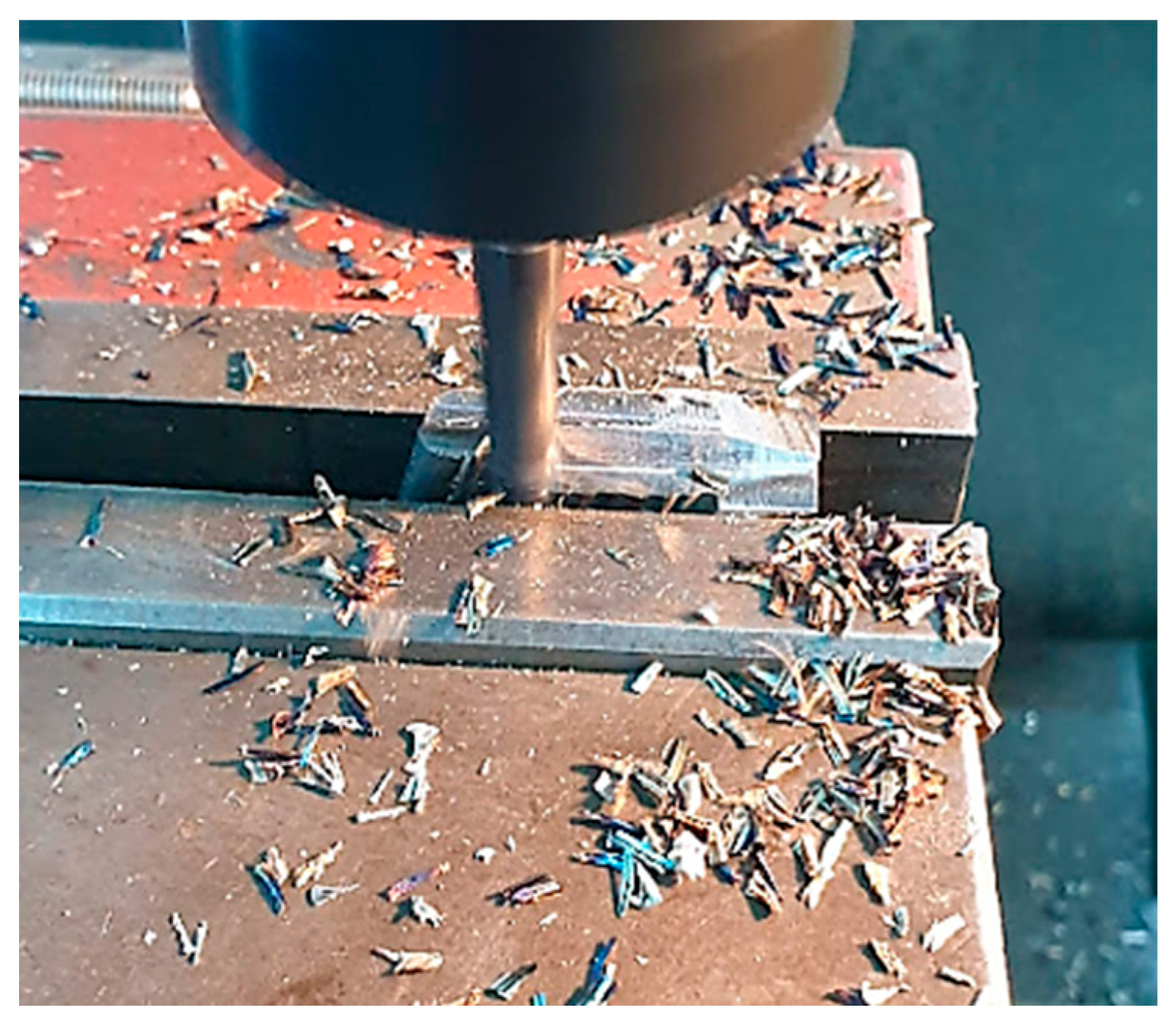

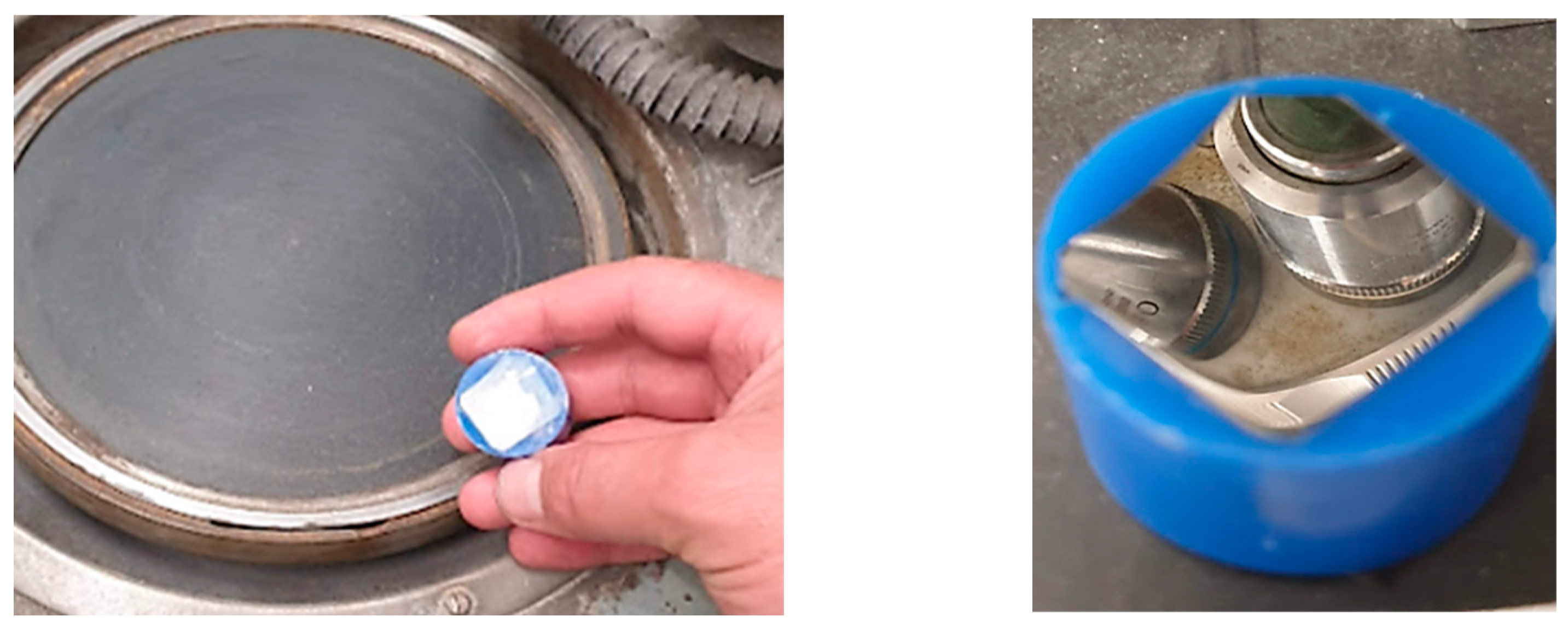
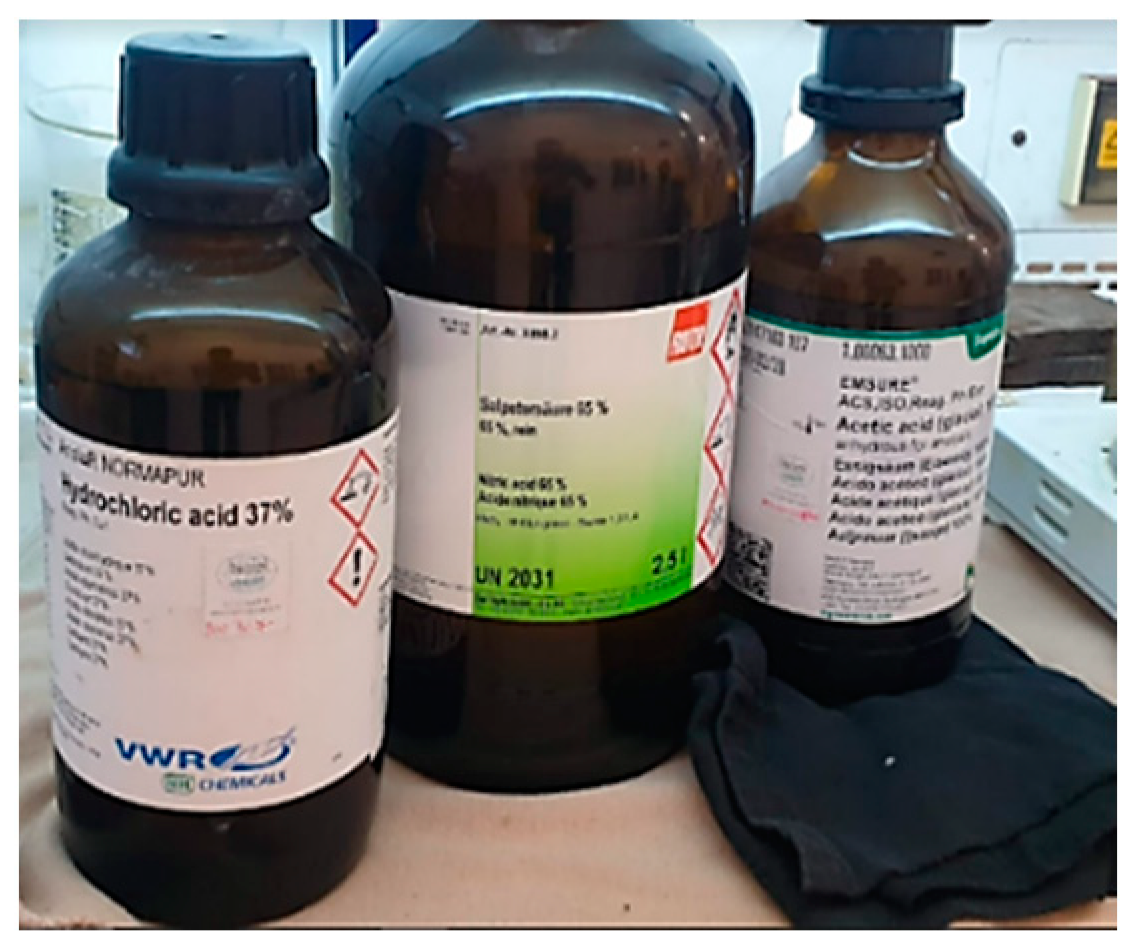
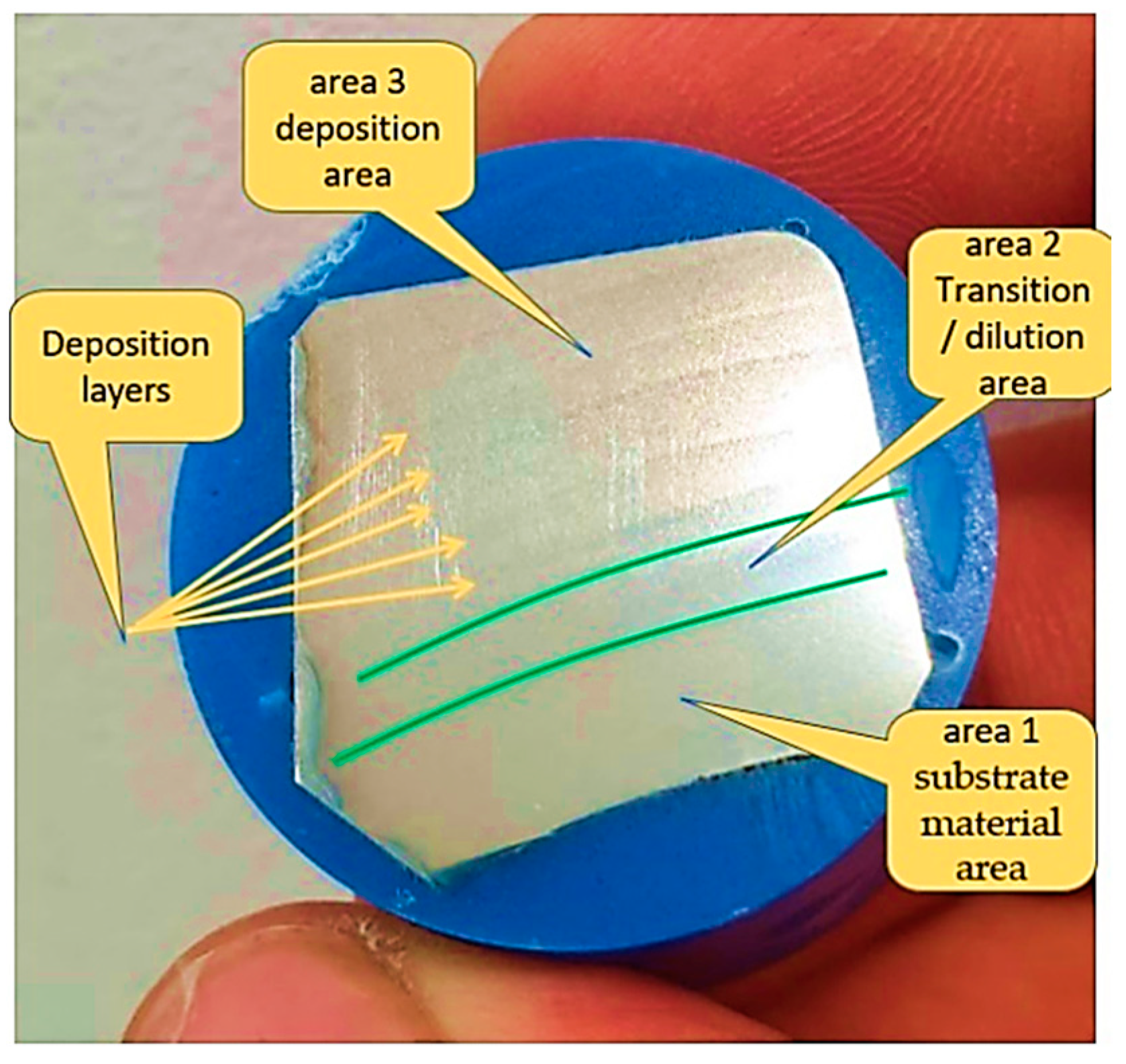
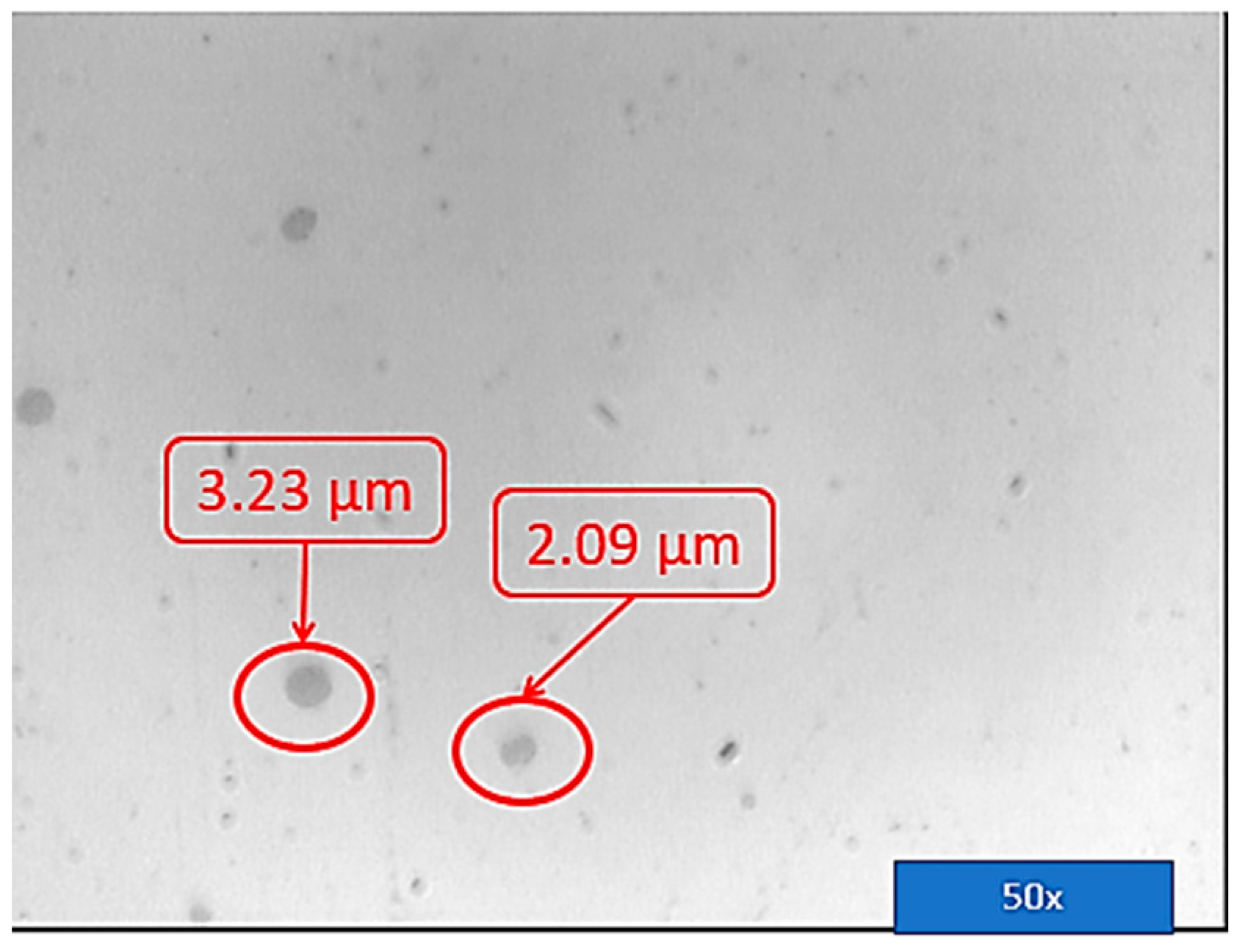
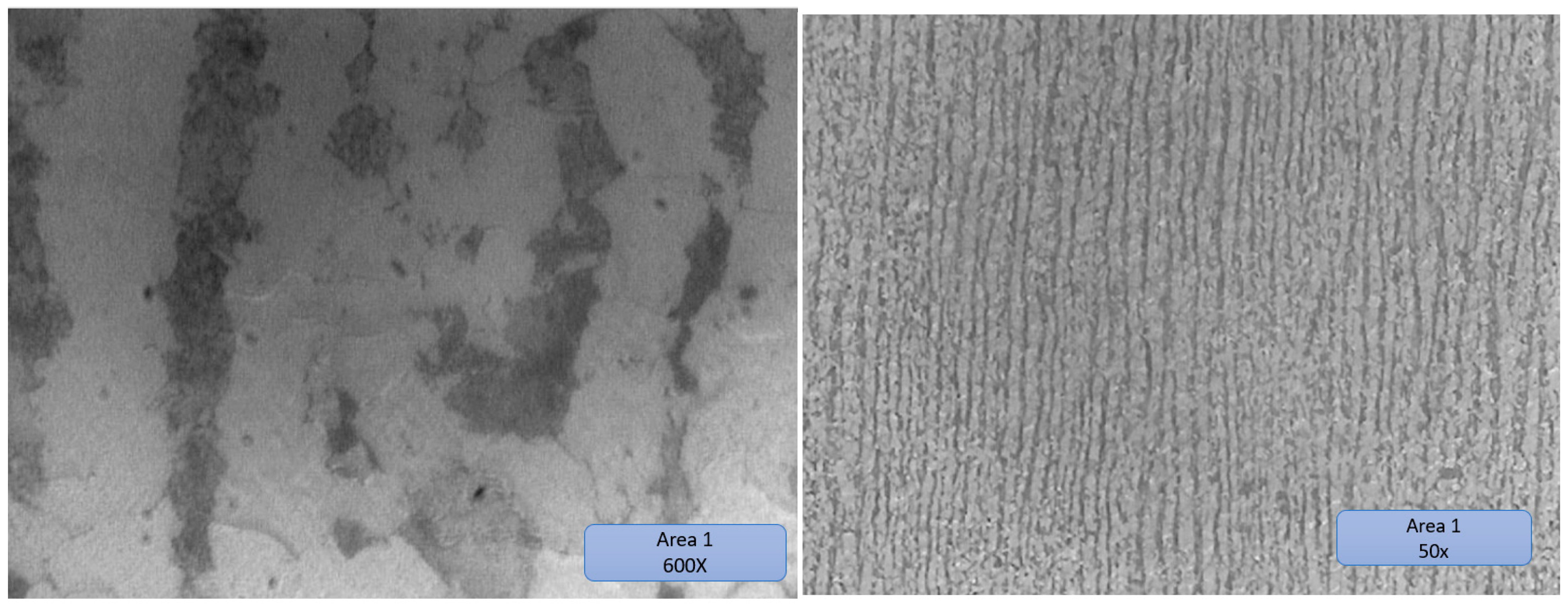
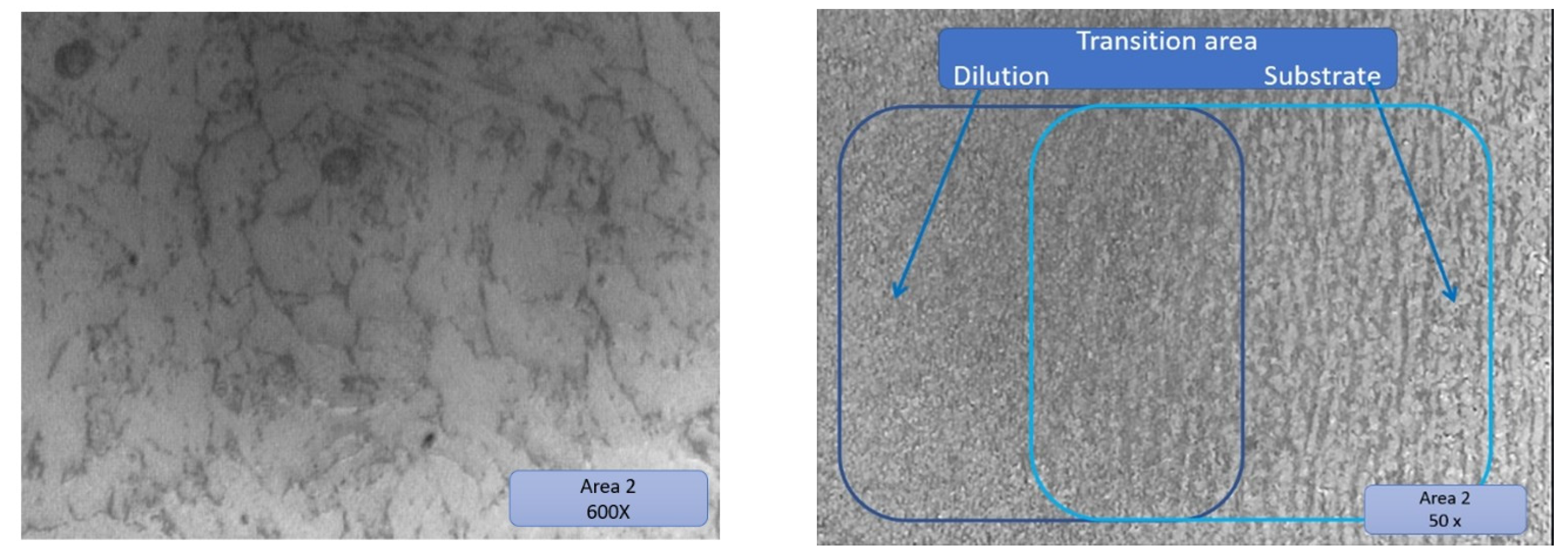
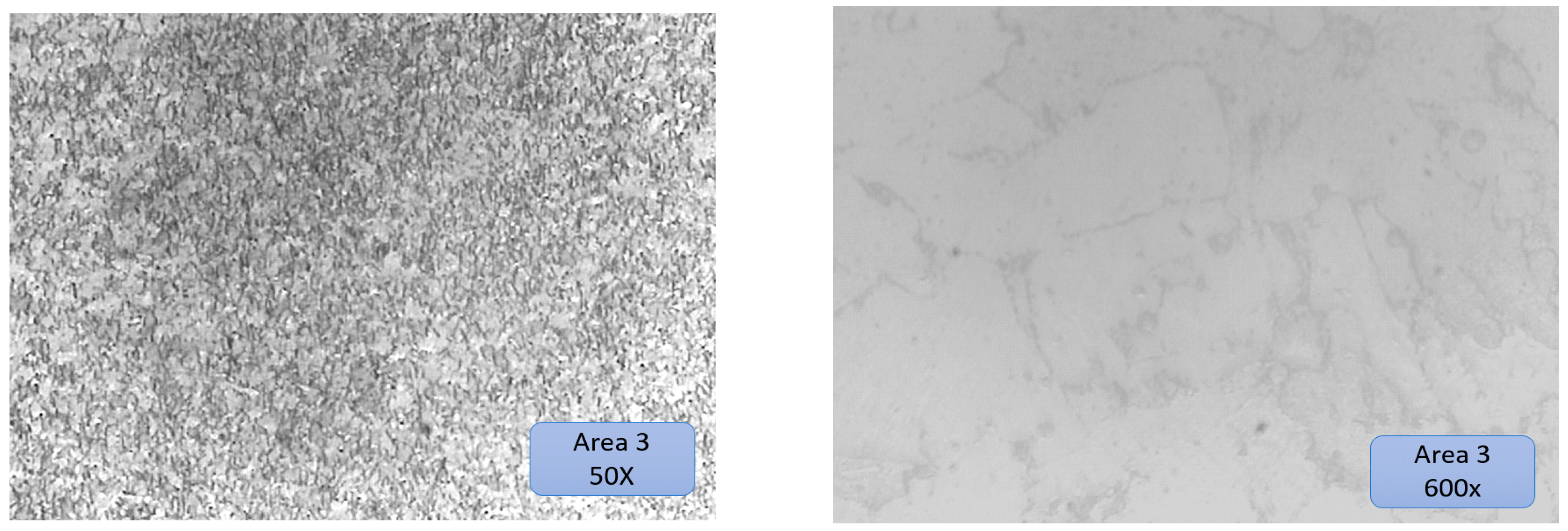
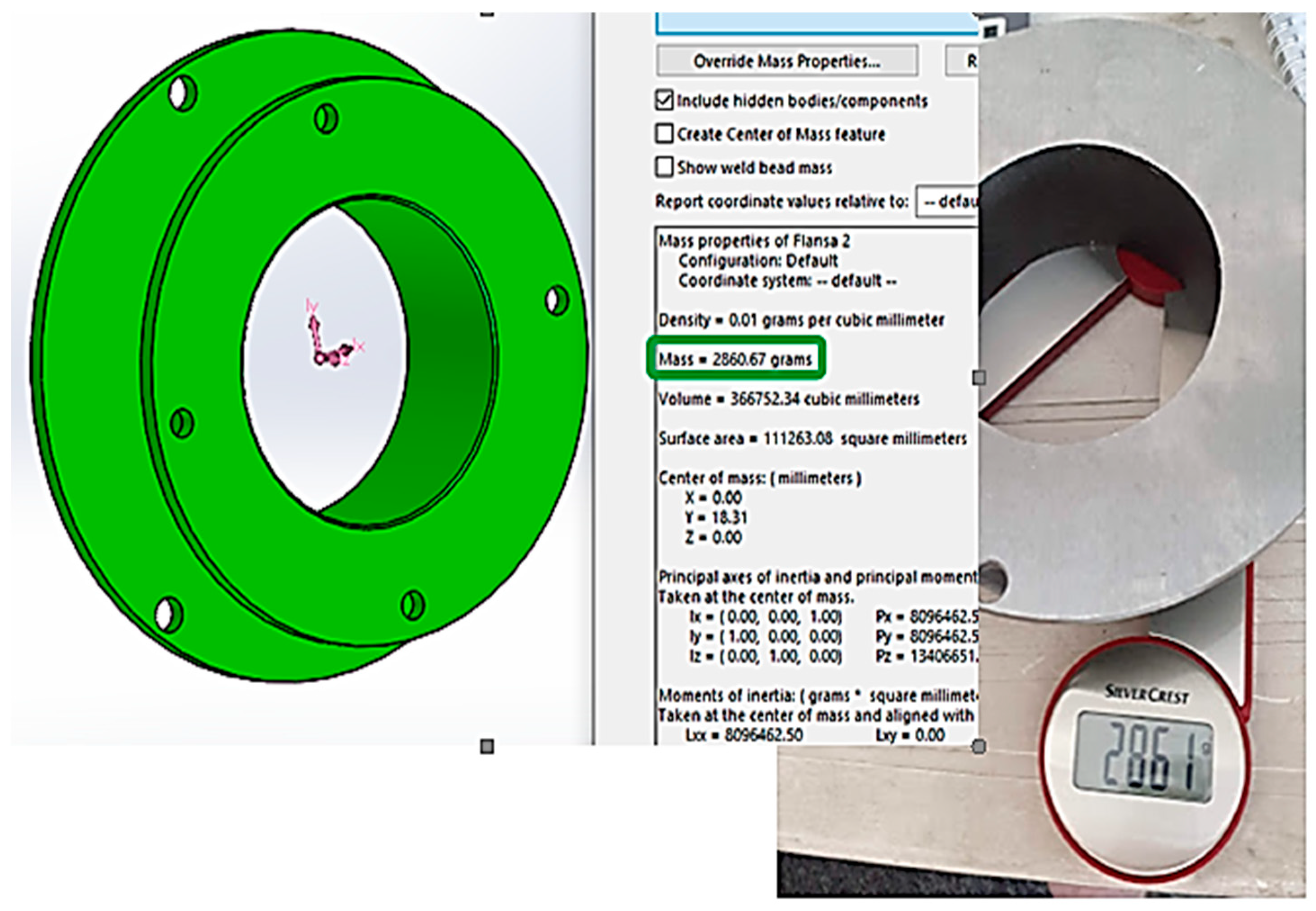
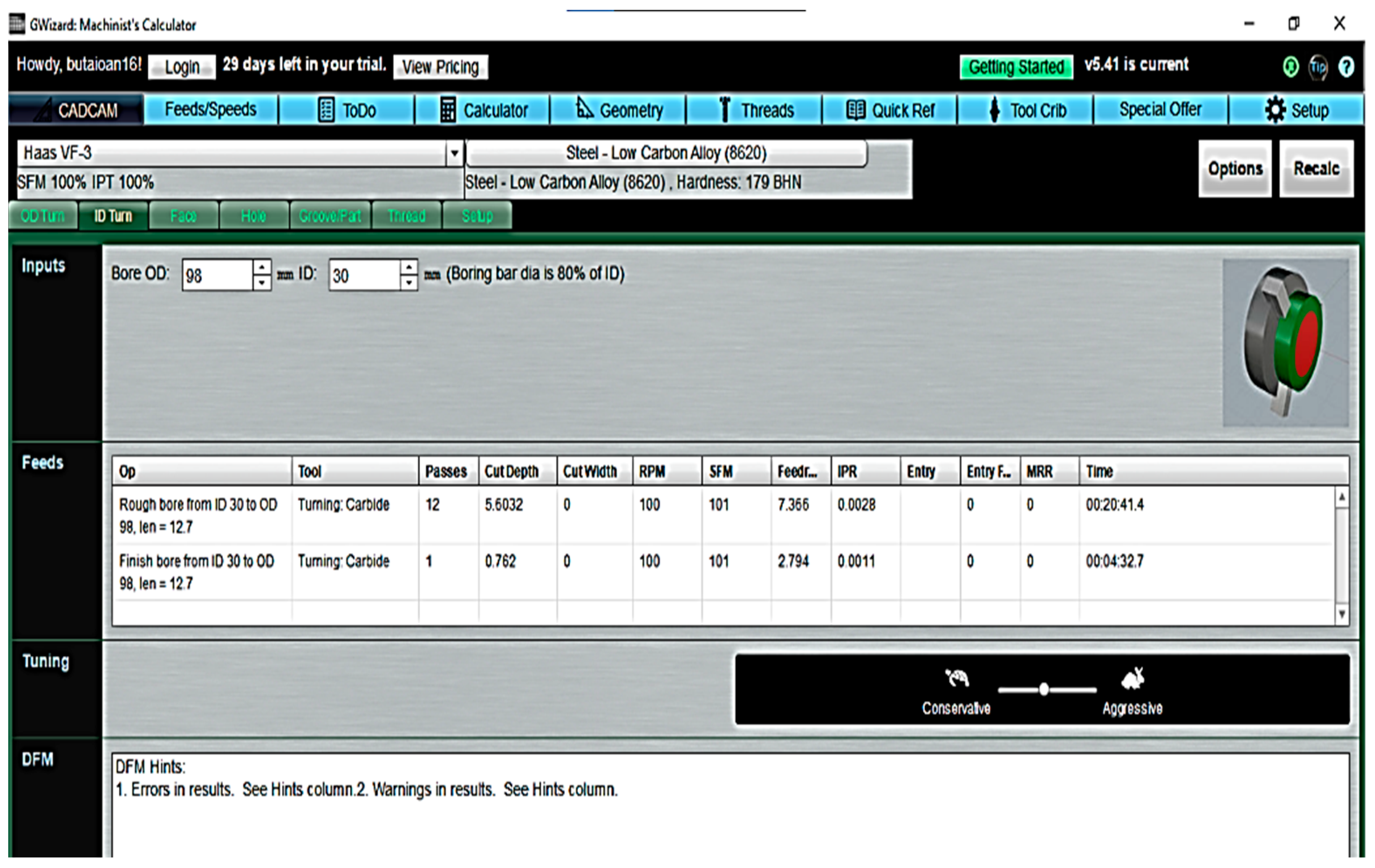
| Technological Parameters | Value |
|---|---|
| Polarity | CC+ |
| Amperage Is (A) | 125 |
| Ua operation voltage (V) | 21.8 |
| Rate of welding (m/min) | 5.4 |
| Gas flow Ar85%-CO215% (L/min) | 15 |
| Medium linear energy (J/cm) | 3096 |
| Length of the free end (mm) | 9 |
| Positioning rotational speed (°/s) | 4.93 |
| Nr.crt. | Test 1 (HB) | Test 2 (HB) | Test 3 (HB) | Test 4 (HB) | Test 5 (HB) | Average (HB) |
|---|---|---|---|---|---|---|
| Zone 1 | 155 | 152 | 155 | 154 | 152 | 153 |
| Zone 2 | 126 | 127 | 129 | 130 | 132 | 128 |
| Mechanical Properties | Value |
|---|---|
| Charge | S355J0 |
| Rm (N/mm2) (SR EN 10025-2) | 510–680 |
| ReH (N/mm2) (SR EN 10025-2) | 355 |
| HB (manufacturer) | 154–208 |
| HB (zone 1) | 153 |
| HB (zone 2) | 128 |
| ReH of solid wire (N/mm2)—from manufacturer | 380 |
| Rm of solid wire (N/mm2)—from manufacturer | 490 |
| Basic Material | Before Processing | After Processing |
|---|---|---|
| Length (mm) | 60.0 | 57.5 |
| External diameter (mm) | 113.0 | 113 |
| Internal diameter (mm) | 98 | 98 |
| Density (gr/cm3) | 7.8 | 7.8 |
| Surface (mm2) | 2485.8 | 2485.8 |
| Volume (cm3) | 1491.47 | 1429.33 |
| Layer weight (gr) | 1163.35 | 1114.97 |
| Piece weight | 4185 | 2861 |
| Material weight of filler | 3021.65 | 1746.13 |
| Quantity of material removed after grinding (gr) | 1276 | |
| Percentage of material use (%) | 57.79% | |
| Percentage of material loss after processing (%) | 42.21% | |
| Electrode wire price G 42 M 21 3Sil (Euro/kg) | 3.52 | |
| Cost wire electrode/piece (Euro) | 10.64 | 6.15 |
| Loss of filler material/piece | −4.49 | |
| material price S355J0 (Euro/kg) | 1.45 | |
| Cost of material/piece (Euro) | 1.69 | 1.62 |
| Loss of material/piece | −0.07 | |
| Total material losses (Euro) | −4.56 | |
| Characteristics | Semi-Manufactured Article | Finished Article |
|---|---|---|
| Length (mm) | 70.0 | 57.5 |
| External diameter (mm) | 200.0 | 113 |
| Interior diameter (mm) | 0 | 98 |
| Density (gr/cm3) | 7.8 | 7.8 |
| Surface (mm2) | 31,415.9 | 2485.8 |
| Volume (cm3) | 21,991.15 | 1429.33 |
| Weight (gr) | 17.153 | 1114.97 |
| Amount of material removed after milling (gr) | 14,292 | |
| Percentage of material use (%) | 16.68% | |
| Percentage of material loss after processing (%) | 83.32% | |
| Prefabricated price (Euro/kg) | 1.45 | |
| Semi manufactured cost/piece (Euro) | 24.87 | 4.15 |
| Loss of filler material (Euro/piece) | −20.72 | |
| Phase | Operation | Ø (mm) | Length (mm) | Times (hh:mm:ss) | |
|---|---|---|---|---|---|
| Clamping 1 | Face turning | Rough turn | 200 | 3.23 | 0:12:45 |
| Turn finish | 200 | 0.76 | 0:15:45 | ||
| outer diameter cutting | Rough turn | 195.762 | 7 | 0:00:33 | |
| Turn finish | 195 | 7 | 0:00:54 | ||
| Rough turn | 170.762 | 7 | 0:01:39 | ||
| Turn finish | 170 | 7 | 0:00:47 | ||
| Rough turn | 113.762 | 43.5 | 0:24:28 | ||
| Turn finish | 113 | 43.5 | 0:03:13 | ||
| Inside diameter machining | Drilling | 30 | 80 | 0:07:10 | |
| Reaming | 98.76 | 80 | 0:20:41 | ||
| Finish ream | 98 | 80 | 0:04:32 | ||
| Clamping 2 | Face turning | Rough turn | 200 | 3.23 | 0:12:45 |
| Turn finish | 200 | 0.76 | 0:15:45 | ||
| Clamping 3 | Hole execution | Front drilling 1 Ø 10.5 × 3 | 10.5 | 7 | 0:15:00 |
| Clamping 4 | Hole execution | Front drilling 1 Ø 8.5 × 4 | 8.5 | 7 | 0:15:00 |
| Effective time to complete the piece: | 2:30:57 | ||||
| Comparative Evaluation of Manufacturing Costs WAAM vs. CNC | |||
|---|---|---|---|
| Cost | Process WAAM Non-Optimized | Process WAAM Optimized | Classic Process (CNC) |
| Cost of raw material/material (Euro) | 12.32 | 12.32 | 24.87 |
| Total production time (min) with WAAM * non-optimized | 202 | 100 | 151 |
| Total machining time after WAAM | 60 | 60 | 0 |
| Hourly rate (Euro) | 30 | 30 | 45 |
| Manpower cost (Euro/hour) | 131 | 80 | 113 |
| Total production cost (Euro) | 143 | 92 | 138 |
| Comparative Evaluation of Manufacturing Costs WAAM vs. CNC | |||
|---|---|---|---|
| Cost | Process WAAM Non-Optimized | Process WAAM Optimized | Classic Process (CNC) |
| Cost of raw material/material (Euro) | 376.65 | 376.65 | 1543.78 |
| Total production time (min) with WAAM * non-optimized | 202 | 100 | 151 |
| Total machining time after WAAM | 60 | 60 | 0 |
| Hourly rate (Euro) | 30 | 30 | 45 |
| Manpower cost (Euro/hour) | 131 | 80 | 113 |
| Total production cost (Euro) | 508 | 457 | 1657 |
Disclaimer/Publisher’s Note: The statements, opinions and data contained in all publications are solely those of the individual author(s) and contributor(s) and not of MDPI and/or the editor(s). MDPI and/or the editor(s) disclaim responsibility for any injury to people or property resulting from any ideas, methods, instructions or products referred to in the content. |
© 2022 by the authors. Licensee MDPI, Basel, Switzerland. This article is an open access article distributed under the terms and conditions of the Creative Commons Attribution (CC BY) license (https://creativecommons.org/licenses/by/4.0/).
Share and Cite
Feier, A.; Buta, I.; Florica, C.; Blaga, L. Optimization of Wire Arc Additive Manufacturing (WAAM) Process for the Production of Mechanical Components Using a CNC Machine. Materials 2023, 16, 17. https://doi.org/10.3390/ma16010017
Feier A, Buta I, Florica C, Blaga L. Optimization of Wire Arc Additive Manufacturing (WAAM) Process for the Production of Mechanical Components Using a CNC Machine. Materials. 2023; 16(1):17. https://doi.org/10.3390/ma16010017
Chicago/Turabian StyleFeier, Anamaria, Ioan Buta, Cosmina Florica, and Lucian Blaga. 2023. "Optimization of Wire Arc Additive Manufacturing (WAAM) Process for the Production of Mechanical Components Using a CNC Machine" Materials 16, no. 1: 17. https://doi.org/10.3390/ma16010017
APA StyleFeier, A., Buta, I., Florica, C., & Blaga, L. (2023). Optimization of Wire Arc Additive Manufacturing (WAAM) Process for the Production of Mechanical Components Using a CNC Machine. Materials, 16(1), 17. https://doi.org/10.3390/ma16010017








